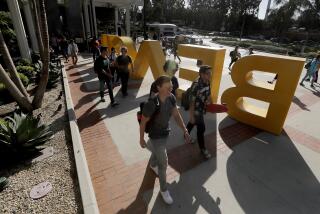Handcuffed Higher Education
- Share via
The University of California regents and the California State University trustees are moving toward establishing new campuses to handle booming college enrollments. Now they must tackle some financial and political realities. Frankly, the prospects aren’t encouraging.
Last week the Cal State trustees gave a go ahead for a new campus at San Marcos in northern San Diego County. They’re also considering a branch in Ventura County. The UC regents approved the study of three new campuses to handle about 20,000 students for whom there may not be enough room by the turn of the century.
California has the resources to provide its young people with excellent higher education while coping with many other public concerns. But the Gann spending limit enacted in 1979 handcuffs the state. It can raise and spend only a portion of the money needed to do these jobs. UC President David Gardner says that there is no way in which the university can accommodate all the qualified students who want to attend unless the Gann limit is lifted. He’s right. It’s time for everyone who agrees with him, from the people who run county hospitals and city jails to those who send their children to play in public parks or use public libraries, to insist that a repeal measure be put onto the 1990 ballot and then to work hard for its passage.
In the meantime, UC and Cal State planners must assume that they won’t get everything they want. One new UC campus, for example, would cost $300 million. So the planners must take a hard look at other ways to manage growth. One thing that they could do immediately would be to ask the California Postsecondary Education Commission to determine whether the state’s private colleges, many of which are excellent, could handle more students. If they could, it might be cheaper and more realistic to expand the Cal Grant program to cover their higher costs than to build entire new campuses.
Working together, the state’s leaders in higher education should also balance spending on new campuses against putting more money and emphasis on improving programs at some existing but less-than-spectacular Cal State campuses. High-quality programs on these campuses could attract some of the bright students now drawn more often to the UC system. San Diego State and Cal Poly San Luis Obispo are strong draws in that system already. What could be done to put, say, Sonoma State or Humboldt State on the map?
A strengthened community-college system could also handle more students who qualify for UC but aren’t ready to move far away from home or can’t afford to do so for the first two years of college.
UC must continue to pay close attention to the growth on existing campuses, which must absorb about 43,000 more students by 2005 even if the three new campuses are approved. Some of the campuses can handle more students easily, and the communities around them want those schools to grow. But several don’t. Santa Cruz is especially sensitive on the growth issue, yet Gardner foresees an increase of 6,051 students at the UC campus there by 2005.
Similar tension has existed over growth at UC Santa Barbara. Gardner’s proposals for a campus growth rate that is even lower than that expected for the area in general should reduce that friction. But there are still problems. There’s not enough parking and too much traffic in the Isla Vista area, near the campus, where many students live. And the campus operates under tight water restrictions. Gardner proposes a growth of 2,176 students, mostly at the graduate level, by 2005. While strengthened graduate programs will add distinction to UC Santa Barbara, more graduate students do require more housing, and that means more water used and more traffic generated.
California’s pride has always been its higher-education system. Now that pride may be hurt unless the state’s university leaders manage this enrollment growth skillfully. Their prospects will improve if the voters finally acknowledge the need to take the state out of its fiscal handcuffs.
More to Read
Sign up for Essential California
The most important California stories and recommendations in your inbox every morning.
You may occasionally receive promotional content from the Los Angeles Times.










